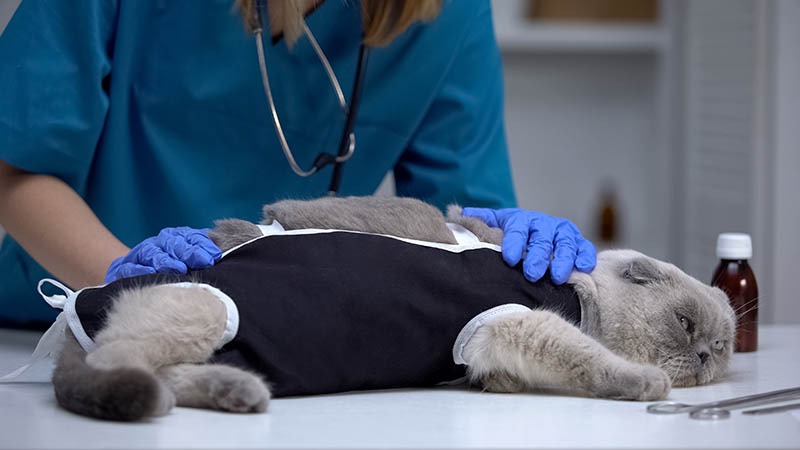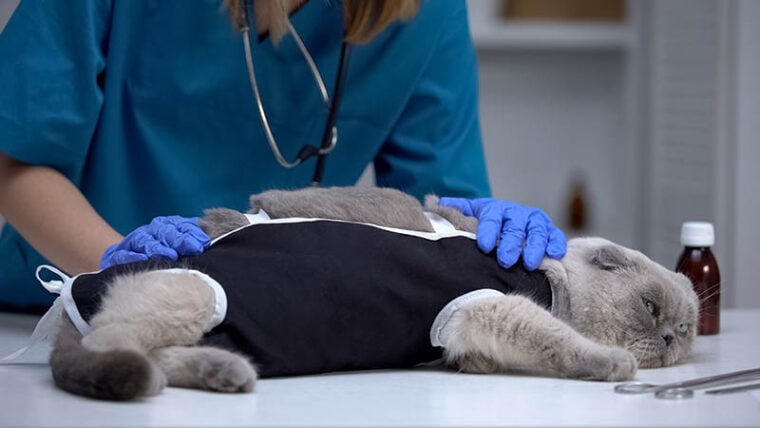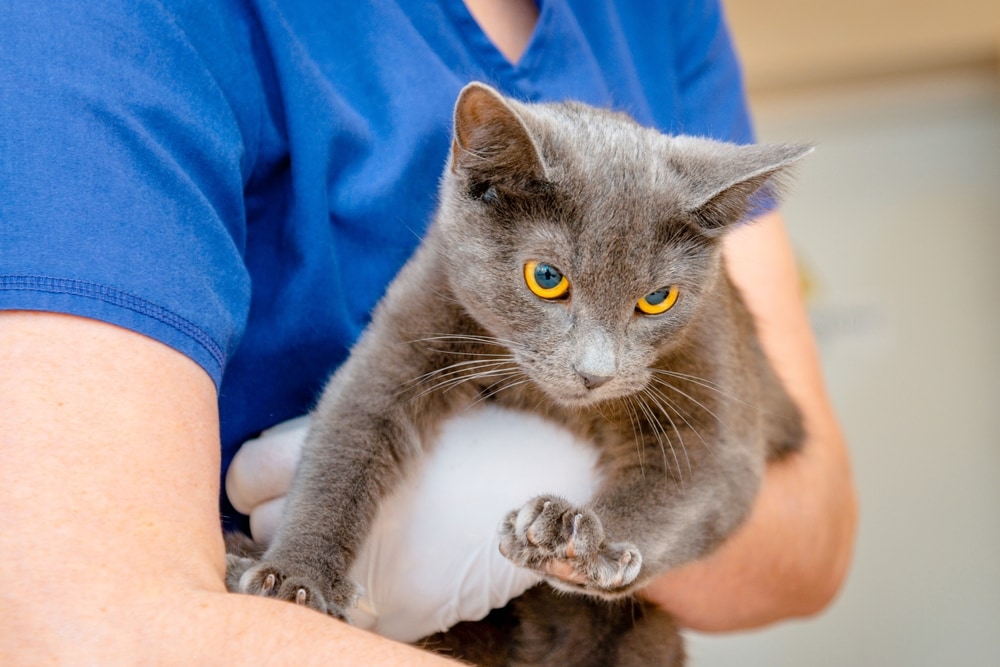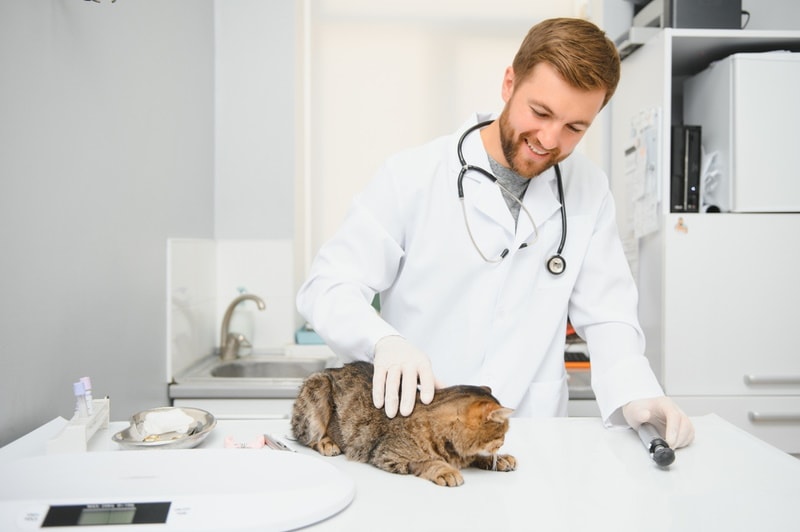- October 19, 2023
How Do Vets Spay Cats? Our Vet Explains Step-By-Step



The information is current and up-to-date in accordance with the latest veterinarian research.
When considering whether to get your cat spayed or not, there are lots of questions to be asked. How do vets spay cats? From what age can they be spayed? What are the advantages of spaying cats? How do I care for my cats at home when they have been spayed?
In this vet-written guide, we will discuss all the important information you will need on how vets spay cats.

What Is Spaying?
Spaying or neutering your cat involves an operation carried out under a general anesthetic where the ovaries and uterus are surgically removed.
It is a sterilization procedure in which your cat’s ability to go into heat and reproduce is removed. The official name of the procedure is ovariohysterectomy which means the removal of both the ovaries and the uterus. In some countries, veterinarians carry out a slightly different procedure called an ovariectomy, which involves the removal of just the ovaries. Both procedures are considered an effective way of neutering. In male cats, the neutering procedure is called castration, this is a completely different procedure and involves the removal of both testicles.
There are many benefits to getting your cat spayed. These include the prevention of unwanted pregnancies, reducing their chances of contracting a sexually transmitted disease, being compelled to stray too far away from home, and getting into fights with other cats.
Cats can be spayed from around 4 months of age, but some owners choose to wait until they are 6 months of age. It is strongly recommended to keep them inside and not let them out before they have had their operation.

Benefits of Spaying Your Cat
There are some very good reasons for spaying your cat. The most important ones to consider are listed below:
Benefits:
- Prevention of unwanted pregnancy: Pregnancy can present many complications that may put your cat’s health at risk. There are many feral cats that cause problems for other cats and wildlife, and shelters are full of stray cats. The numbers are rising regularly too. If your cat is spayed, she won’t be able to add to the cat population.
- Reduction in risk of cancer: Spaying your cat reduces the risk of mammary cancers and eliminates the risk of uterine cancer.
- Reduction in risk of reproductive diseases: If your cat is spayed, it will eliminate the risk of them developing infections in the uterus (also called pyometra) and other reproductive diseases such as uterine torsion and cysts.
- Reduction in risk of sexually transmitted diseases: There are some diseases that cats pass into each other via sexual intercourse such as Feline Immunodeficiency Virus, Feline Leukemia Virus, Chlamydia, Feline Herpes Virus, and Brucellosis.
- Stop heat cycles: If your cat is spayed, they will not have the circulating hormones that trigger heat cycles. This will also prevent all the unwanted attention this brings from male cats.
- Prevents roaming: Your cat will be less likely to get the urge to stray far from home in search of a mate. This will prevent them from being in unfamiliar environments and potentially getting injured as it will reduce their exposure to cars, and wild animals as well as other cats.
- Reduced behavioral issues such as fighting: Your cat will be less likely to have altercations with other cats over territory or mating.
The Spay Procedure
This is a surgical procedure which is always carried out under general anesthesia.
Preparation:
- Your vet will need to examine your cat to determine if they are fit and healthy enough to endure a general anesthetic. They will check them over from top to tail and listen to their lungs and heart. If any problems are flagged, they will discuss everything with you in detail.
- Your cat needs to be fasted overnight before the operation, usually for a minimum of 6–8 hours. Your vet will advise you on the exact timings. This is to ensure their stomach is empty so that there is minimal risk of them choking or regurgitating under the general anesthetic. They can eat their normal food the night before but take the bowl away after that.
- Water needs to be taken away early in the morning, around 6 a.m.
- Keep your cat indoors overnight so that you will be able to control what they eat and drink and also so that you can catch them.

The Day of the Operation
Day of the Operation:
- You will bring your cat to the veterinarian hospital, and they will be admitted as an inpatient for the day. Your vet will check over your cat again and ask if there have been any recent health issues or ongoing unresolved problems. They will also double-check that your cat hasn’t eaten or drunk anything for the correct time frame.
- Your cat will be taken through to a warm kennel and they will receive a premedication injection into their muscle that relaxes them. They will be left alone but monitored closely while this takes effect. Once the premedication is on board, your cat will be given a full general anesthetic and appropriate pain relief.
- The nurses will begin to prepare the skin of your cat for surgery. This involves clipping the fur from a patch on either the left abdomen or along the midline of their stomach (depending on where your vet is going to enter the body). The area is then scrubbed with a solution to make it sterile.
- Your vet will begin the surgery. A small incision is made to allow access into the abdomen with a sharp scalpel blade. Your vet will carefully dissect the different layers until they reach the abdominal cavity. Once in here, they will locate the uterus and ovaries. They are all removed.
- The abdomen is then stitched up in its different layers. Finally, the skin is stitched up.
- Your cat will be gently woken up from the general anesthetic, whilst being closely monitored. They will stay in their warm kennel for most of the rest of the day and will be offered food and water.
- When your vet decides they are fit enough to be discharged, they will call you to arrange collection and go over everything with you. You will be sent home with pain relief for your cat.
- Your vet will arrange to see your cat for some post-operative check ups to ensure the wound is healing well and there are no complications.
- Depending on what suture material was used, your cat may need them removed. Your vet will arrange an appointment for them to be removed if this is necessary.
- Your cat will need to stay indoors for at least 2 weeks while the incision heals. Your cat will need to be monitored closely. It is important to ensure they are eating, drinking, and going to the toilet normally and that the wound is healing well.
Potential Complications
The neutering procedure is generally very safe, however, some complications may arise, as is the case with any surgery under general anesthetic.
Complications include:
- Anesthetic complications: All general anesthetics come with a risk. There is always a risk of adverse reactions, it depends on the individual and how their body processes the drugs. These can range from swelling at the injection site to anaphylaxis or even death.
- Wound infection: It is possible for the wound to become contaminated with bacteria and an infection can become established.
- Inflammation: Redness and swelling of the wound can occur and cause the cat discomfort and pain.
- Slipping of ligatures and bleeding: This can occur during or after the surgery and may require the wound to be reopened to stop the bleeding.
- Herniation of abdominal tissues: If there is a breakdown in the sutures in the abdominal wall.
- Hematoma or seroma at infection site: Swelling and accumulation of blood and tissue fluid may occur. This usually resolves without intervention but does need to be monitored closely.
- Gastrointestinal upset: This can occur due to the anesthetic but normally only lasts for a short amount of time.


Frequently Asked Questions (FAQs)
Will my cat need to wear an e-collar after being neutered?
Most cats will be sent home wearing an e-collar. This prevents them from licking the surgical site and potentially introducing infection or causing the wound to break down. Some cats will fuss and lick more than others, so it does depend on the individual to a certain extent.
Will neutering cause my cat to gain weight?
Due to the reduction in circulating hormones, your cat may end up needing less to eat than before they were spayed. It is usually advised to reduce portion sizes or change their diet to one containing fewer calories. Only do these things after a discussion with your vet.
Does my cat that lives solely indoors need neutering?
Yes, you should still neuter your cat even if they don’t go outside. All of the health benefits mentioned above will still apply, such as the prevention of pyometra, cancers, and uterine torsion. If your cat comes into heat indoors it can be stressful for them too.

Conclusion
In most scenarios, it is in your cat’s best interest to get them spayed. If you plan to breed your cat, you must do this responsibly and under the guidance of your vet. There are many benefits of spaying your cat, including avoidance of various health issues as well as behavioral benefits. The spay operation is generally quick and straightforward and your cat is expected to recover within two weeks.
It does come with risks, as with any surgical procedure under general anesthesia. If you have any concerns, your vet will happily talk it over with you.
Featured Image Credit: Motortion Films, Shutterstock
Tags
What do you think?
Related Articles

New Puppy Checklist: Gear You’ll Need for Your New Dog
Getting a new puppy is really exciting, but before you welcome them home, it’s important to prepare your space for them. Since puppies need a

How Big Do Mini Poodles Get? Vet Reviewed Average Weight & Growth Chart – Dogster
The information is current and up-to-date in accordance with the latest veterinarian research. Learn more » When you buy a Miniature Poodle, you might not

Can Police Dogs Smell Nicotine? Vet Verified Facts & Info – Dogster
The information is current and up-to-date in accordance with the latest veterinarian research. Learn more » While cigarette sales have been declining steadily for decades,

How Old Is 5 in Dog Years? Vet-Approved Guide to Each Size of Dog – Dogster
The information is current and up-to-date in accordance with the latest veterinarian research. Learn more » A common method for calculating a dog’s age is

